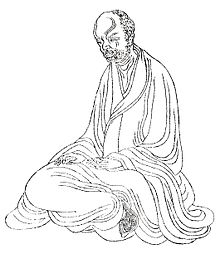Lushan Huiyuan

Lushan Huiyuan (
Huiyuan was posthumously named First Patriarch of the
Life


Huiyuan began studying the
In the year 402 he organized a group of monks and lay people into a
In the year 404, Huiyuan wrote On Why Monks Do Not Bow Down Before Kings (沙門不敬王者論).[4] This book symbolized his efforts to assert the political independence of Buddhist clergy from the courts of monarchic rulers. At the same time, it was a religious and political text that aimed to convince monarchs and Confucian-minded ministers of state that followers of Buddhism were ultimately not subversive. He argued that Buddhists could make good subjects in a kingdom due to their beliefs in retribution of karma and the desire to be reborn in paradise. Despite the Buddhists' reputation of leaving their family behind for a monastic life, Huiyuan stated "those who rejoice in the Way of the Buddha invariably first serve their parents and obey their lords."[1]
See also
- Buddhism in China
- Chinese philosophy
- White Lotus
References
- ^ a b Ebrey, Cambridge Illustrated History of China, 97.
- ^ Jones, Charles B. (2008). Was Lushan Huiyuan a Pure Land Buddhist? Evidence from His Correspondence with Kumārajīva About Nianfo Practice, 周文廣 - Chung-Hwa Buddhist Journal 21, 175-191
- ^ Shinko Mochizuki, Leo M. Pruden,Trans. (2001). Pure Land Buddhism in China: A Doctrinal History, Chapter 3: Hui-yuan of Mt.Lu, Pacific World Journal, Third Series, Number 3, 251
- ^ For a translation, see Leon Hurvitz, " 'Render unto Caesar' in Early Chinese Buddhism," Sino-Indian Studies, V, 4 (Santininketan), 80-114.
Bibliography
- Bary, Theodor de (1999). Huiyuan: A monk does not bow down before a king. In: Sources of Chinese tradition, vol. I, New York: Columbia University Press, pp 426-432
- Ebrey, Patricia Buckley (1999). The Cambridge Illustrated History of China. Cambridge: Cambridge University Press.
- Tanaka, Kenneth Kenichi (1990). The dawn of Chinese pure land Buddhist doctrine : Ching-ying Hui-yuan's Commentary on the Visualization sutra, Albany : State University of New York Press
- Zheng, Changji (972). "The Tale of Master Yuan of Mount Lu". In Mair, Victor H.; Steinhardt, Nancy S.; Goldin, Paul R. (eds.). Hawai'i Reader in Traditional Chinese Culture. Translated by Sen, Tansen; Mair, Victor H. Honolulu: University of Hawai'i Press (published 2005). pp. 304–339. ISBN 0824827856.
- Zürcher, E. and Teiser, Stephen F. (2007). Buddhist Conquest of China : The Spread and Adaptation of Buddhism in Early Medieval China (3rd Edition). Boston, MA: Brill Academic Publishers, pp. 204–53.
